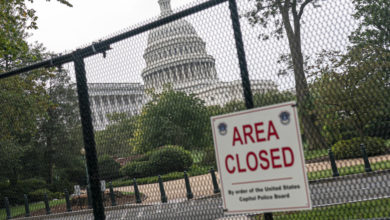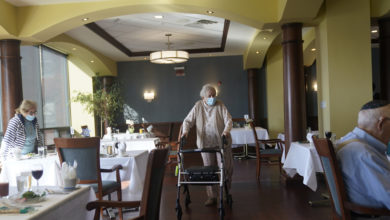SCAD’s Paula Wallace on the Perfect WFH Workspace

Paula Wallace, legendary design maven and SCAD president and founder, knows a thing or two about creating spaces for creative flourishing. In the 42 years since she created SCAD, one of the world’s elite arts universities, Wallace has rehabilitated, resurrected, created, and designed some of the most inventive and inspiring university environments, transforming 100+ historic properties (from medieval stone chapels in the South of France to 19th-century railroad complexes and midcentury corporate headquarters in the U.S.) into classrooms, studios, galleries, museums, residence halls, and offices for tens of thousands of students, faculty, and staff. When COVID-19 compelled the entire SCAD community’s transition to WFH (work from home) environments, Wallace and her team applied their years of design thinking to creating WFH workspaces that were productive, practical, and perfectly suited to virtual learning and endless Zoom meetings.
“I had to reimagine my own home workspace, too,” Wallace said. “I needed something that looked great–and not distracting–on camera, but is also suited to quiet reflection. When I’m not interviewing guests for On Creativity or leading SCAD meetings on Zoom, I do a lot of reading and writing and editing.”
The key to creating any functional WFH space, she says, is to remember its purpose: productivity. “This is not a recreation area! All of us need to remember that. Let your workspace be for work.”
Work the Walls
Zoom, Wallace says, has us all thinking long and hard about walls. “What do people see behind us?” she says. “That’s the #1 concern for any WFH environment, really. Salon walls are always an option.” Any guest to SCAD will find salon walls galore, filled with contemporary and vintage portraiture. “Salon walls create visual interest and tell a story. I love making up stories about the characters on the walls at the entrance of Ruskin Hall,” she says, referring to the rehabilitated 19th-century hospital that now serves as the home of SCADpro and other university offices.
Wallace reminds us not to forget the other walls, too–those not visible to Zoom callers. “Curate your workspace like a gallery. Find your statement, either cerebral or punchy, that reflects what inspires you. The color and unique art work on my WFH walls keeps me in a creative headspace, even when I’m not on camera.”
(Don’t) Watch the Windows
Everybody loves and needs time in nature, but according to Wallace, beware the distraction of windows in your WFH space. “As one designer memorably told me, ‘Windows belong above the kitchen sink.’” Wallace suggests the arrangement of seating turned away from windows. And if your WFH area features many windows that distract, consider hanging art in one of them. “My office features three broad windows. I hung a large painting over the center window, letting in just enough of the fantastic Lowcountry light to do its work.” This way, sunlight gets in, but not distractions.
Pick Your Playlist
“Research has shown what most of us already know,” Wallace says. “Listening to music encourages efficiency and creativity. Deep thinking — reading, writing, analyzing long documents — is best aided by more narrative compositions, sonatas, film scores, just about any track from Miles Davis’s Kind of Blue or your preferred white noise via YouTube (one of my colleagues prefers a 10-hour video of an idling polar icebreaker in the Arctic Ocean).”
Paula Wallace SCAD suggests creating playlists that reflect different tasks: Chance the Rapper for rapid-fire tasks that need energy, T. Swift’s Folklore for quiet research. “And don’t forget to give yourself a break from music, too,” she says. Phone calls and Zoom meetings don’t need a soundtrack.”
Color Me Productive
People have very different days and very different roles. Wallace encourages us to choose colors that complement the vibe of the work. “If your workday includes frequent episodes of stress and intense feeling, such as difficult conversations or urgent phone calls, then go with low-wavelength colors like blue and green to induce calm,” she says. “These colors can improve efficiency and focus, also.” Contrariwise, those of us whose work requires sustained creative thought might choose brighter hues, like yellow, which can stimulate creativity. “Yellow is primitive. It reminds us to make hay while the sun is shining!” she says.
Stand in the Place Where You Live
“On Zoom calls, I stand most of the time,” Wallace says. “The energy is better when I stand!” If she needs to write or take notes, she sits. Standing at a desk or on camera increases blood-flow and aids productivity and communications, in Wallace’s experience. And when it’s time to sit, consider creating secondary seating options: one chair for reading and research, another for working Zoom calls. “You needn’t create a living room in your office,” she says. “Anything can work for seating: narrow perches, pull-up stools, hassocks, even floor cushions.”
Make WFH Work for You
“Design a WFH space the way you design yourself. Your clothing and what you carry on your person tells you a lot about what kind of workspace you need,” Paula Wallace of SCAD says. If you’re always toting a Moleskine notebook full of to-do lists, then your WFH workspace needs a white board. If you dress casually in the office, then find ways to make your home workspace equally reflective of that vibe. “Just no pajamas,” she says. For Wallace, authenticity begets your best ideas.
“The most productive workspace is a space in which you feel comfortable and confident,” Wallace says. “Create a workspace that gives you that feeling every day. Your best ideas are sure to follow.”
Learn more about productivity from Paula Wallace on YouTube or Thrive Global





